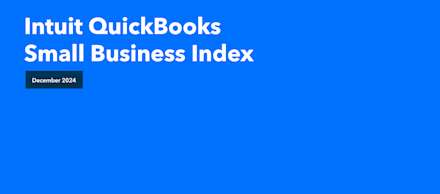
Intuit QuickBooks Small Business Index, December 2024
Simple, smart accounting software - no commitment, cancel anytime

SUPPORTING YOUR CLIENTS
Accountants and bookkeepers are helping small businesses grapple with ongoing uncertainty in all sectors of the economy. The advice you give to your small business clients is pivotal. By helping them to manage their cash flow they can be as resilient as possible.
Understanding the amount of cash small businesses have is key to informed decision-making. We’ve created this guide to make it easier for you to assess your clients’ situation quickly and help them achieve and maintain positive cash flow. Forecasting tools, combined with industry best practices and details about government resources, will give you a range of options for your clients, with the goal of staying cash positive.
Some of your clients will need help sooner than others. If you identify the clients who need your immediate attention you can go on to create an action plan across your practice.
Your clients’ vulnerability will depend in large part on their industry and the number of employees they have. Several industries are facing significant challenges, including entertainment, retail, hospitality, automotive, and other service-based sectors. Prioritising your clients based on the type of business they have can help you manage your outreach strategy.
Use our forecasting spreadsheet to see how long a client can maintain their typical business operations, then make adjustments to create a three-month plan to stay cash positive.
Before you start, make sure all transactions are reconciled and the books are clean. To put together the forecast, you’ll need the data from a few reports from your accounting software or excel. You can find instructions on how to do this in QuickBooks here.
Run a Profit and Loss report for the past three months to understand the average income and expenses for each month. For income, focus on the top sources of revenue. On the expense side, pay particular attention to payroll, rent, insurance, and marketing expenses.
Run the Open Invoices report so you’ll be able to see anticipated sources of cash.
Run the Unpaid Bills report to identify expected short-term cash outflows.
After you analyse the current cash situation and develop a forecast, identify the best ways to help clients adjust their cash flow management. They’ll probably need to implement a combination of approaches to both increase money coming in and decrease what they spend. Use the data from key QuickBooks reports to come up with recommended courses of action.
Speeding up existing revenue streams or finding new ones can give clients an injection of cash that they can use to keep their business on track.
Accelerate accounts receivable
QuickBooks has several reports to help you quickly identify which customers have outstanding balances and who owes the most. You and your clients can then choose how to manage these accounts to increase available cash.
To see which customers owe the most, use the Open Invoices report.
For a detailed breakdown of how much each customer owes and the due dates, check the Customer balance detail report.
Explore relief funding options
A range of support is available for small businesses from the UK Government. You’ll find details of The Coronavirus Job Retention Scheme, The Self-employment Income Support Scheme, The Coronavirus Business Interruption Loan Scheme and the Bounce Back Loans Scheme and more on our dedicated COVID-19 website.
Other ideas
Work with your clients to adjust their business models and increase their revenue options. Setting up an online business or offering services remotely and using personalised invoices to speed up payments are just a few practical options.
Several strategies which help clients manage their expenses will have an immediate effect on their cash flow.
Lower or defer payments
Encourage clients to work with suppliers, lenders, and government agencies to explore options for deferring payments or restructuring terms and rates. Use report data from QuickBooks to help your clients prioritise who to contact and use tips on communicating with suppliers.
Reduce fixed expenses
Large monthly expenses are the easiest to identify. Lowering them can have a substantial impact on the cash that’s available for the business.
Rent: Use the rent or lease QuickReport to get the average monthly rent expenses.
Insurance: Use the Transaction detail by account report to see monthly insurance expenses.
Payroll: Help your clients assess a variety of options for managing their workforce. Or see if your clients qualify for the Coronavirus Job Retention Scheme.
Check current bill status
Start with the bills that are already due (or overdue). Suppliers may be flexible on timing or be able to offer payment plans.
The Unpaid bills report will give you a snapshot of due and overdue bills.
To see how much you owe each person or company, use the Expenses by supplier summary.
Explore options to defer loans and taxes
To identify lenders or other note-holders to contact about deferring loan payments, use the Transaction detail by account report.
For a list of the client’s tax agencies, use the Taxable sales detail report. VAT payments are now automatically deferred.
To calculate how much payroll tax the client pays, use the Total payroll cost report.
Cut back discretionary spending
There’s a wide range of expenses that clients can control. Identifying items that aren’t necessary—either in the short term or at all—can alleviate pressure on cash flow.
Recurring expenses
Your clients probably have several monthly or quarterly outgoings that aren’t essential in the short term. Help them find potential savings by identifying recurring transaction patterns, then cancelling or suspending supply orders, subscriptions, or memberships. To see all transactions for a specific time period, grouped by vendor, run a Transaction list by vendor report.
Marketing and advertising
Marketing budgets typically have some flexibility, and clients should be able to adjust them for the next few months. To see average spending, use the Transaction detail by account report.
We hope you and your firm find this forecasting tool is helpful in advising your clients during this time. You can find more cash flow support on our dedicated COVID-19 support site.
9.00am - 5.30pm Monday - Thursday
9.00am - 4.30pm Friday